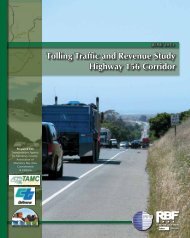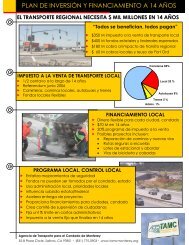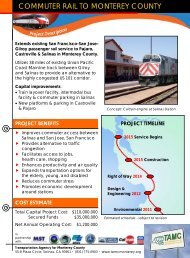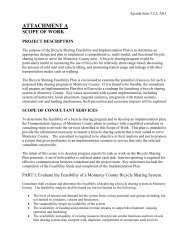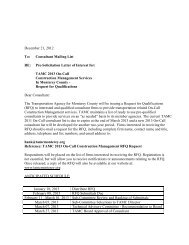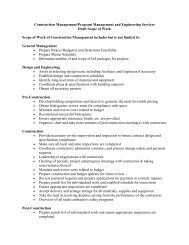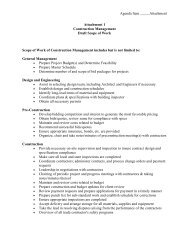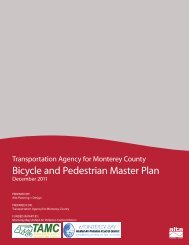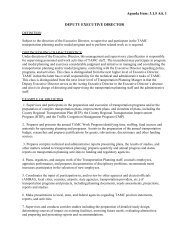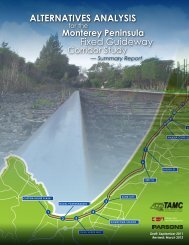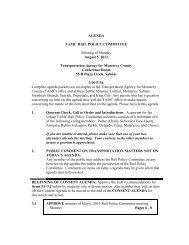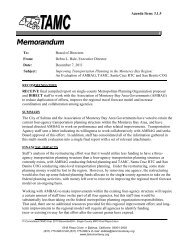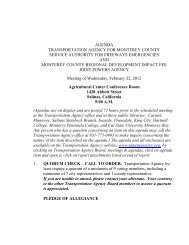Commuter Rail Extension Alternatives Analysis - Transportation ...
Commuter Rail Extension Alternatives Analysis - Transportation ...
Commuter Rail Extension Alternatives Analysis - Transportation ...
You also want an ePaper? Increase the reach of your titles
YUMPU automatically turns print PDFs into web optimized ePapers that Google loves.
CALTRAIN EXTENSION TO MONTEREY COUNTYALTERNATIVES ANALYSISVehicle Operating CostsVehicle operating costs were calculated for the No Build and Caltrain <strong>Extension</strong>/Express Busalternatives using estimates of vehicle miles traveled (VMT) reported in Table 8-10.In lieu of calculating fuel consumption per gallon based on average link speeds and vehicle milestraveled per link, an average rate of vehicle fuel economy was used based on EnvironmentalProtection Agency (EPA) laboratory data adjusted downward by about 15 percent to better representreal-world driving conditions. In its annual report released on July 17, 2006, the EPA said the industry-widefuel economy of 2006 model-year vehicles was 21 miles per gallon, the same as a yearago. 10The resulting average fuel consumption of 0.0476 gallons/mile corresponds reasonably well with theestimates of average fuel consumption for the Year 2000 obtained from the California Air ResourcesBoard’s Motor Vehicle Emission Inventory models. These rates, used in the California Life-CycleBenefit/Cost <strong>Analysis</strong> Model, are reported in Table 8-11.The price-per-gallon of regular grade gasoline was assumed to be $2.995 per gallon, based on pricesprevailing in Salinas, California in March 2007. 11 This cost was separated into tax and non-taxcomponents, using the tax portion to compute “revenue transfers.” The tax rate per gallon of gasolinewas assumed to be 18.4 cents federal, 18.0 cents state excise, 18.1 cents state sales, 3.8 centscounty sales, and 1.2 cents per gallon UST fee. These taxes total 59.5 cents per gallon.Non-fuel costs for vehicle maintenance and tire expense were assumed to be $0.061 per mile forautomobiles based on Center for <strong>Transportation</strong> <strong>Analysis</strong>, Department of Energy statistics for calendaryear 2004. This cost does not include mileage-based depreciation.The resulting vehicle operating cost benefits of the Caltrain <strong>Extension</strong> and Express Bus alternativeimprovements, computed for Year 2030 passenger volumes, are estimated to be $12 million annuallyas shown in Table 8-12. Revenue transfers and fuel taxes not collected as a result of these benefitsamount to $1.7 million annually in 2030.Transit User FeesThe transit user vehicle operating cost savings reported above must be offset by the fares users payto ride the proposed transit service. Table 6-13 lists the anticipated fare revenues for different levelsof ridership. For the 2010 and 2030 planning horizons, the anticipated revenue from passenger fares(user fees) are as follows, based on the Caltrain fare structure in place as of January 1, 2006.• Year 2010 annual passenger revenue = $3,310,612• Year 2030 annual passenger revenue = $6,320,79010Washingtonpost.com, “Gas Prices Are Up but Not Fuel Economy,” July 18, 2006.11www.fuelgaugereport.com for March 7, 2007.parsons CHAPTER 8: EVALUATION OF ALTERNATIVES 183



